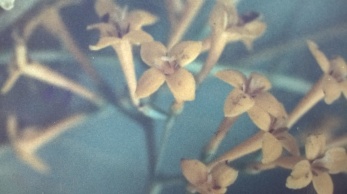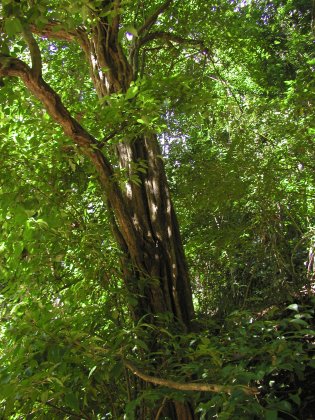Chomelia microloba J.D.Smith
Rubiaceae FOSFORILLO
Occasional evergreen understory or subcanopy tree (15-20 m) most frequently found in regions of dense, low-lying primary forest where the air is humid and the soils are nearly always water-saturated. Resembling a tightly packed cluster of fused and interwoven poles, Fosforillo has a highly unlikely trunk that makes this species unique among Costa Rican arboreal flora. The tree also sports an esthetically pleasing, dense crown of glossy-green foliage that is occasionally ornamented with discreet splashes of delicate yellow flowers.
Description: Fosforillo is an easily recognizable tree species thanks to its peculiar trunk. Of moderate size (to 70 cm), it has a very irregular cross section and an angular growth habit. The surface of the bole is composed of a compact set of closely spaced folds. As they climb the outside of the trunk, these contours trace meandering paths, occasionally merging and diverging with neighboring folds. So irregular is this arrangement that a Fosforillo trunk resembles more a clump of pole-sized sticks – loosely and haphazardly lashed together – than a single coherent stem. Branching occurs along almost the entire length of the trunk and the relatively large, often arching, limbs emerge at apparently random locations and without symmetry. The crown they form is variable in shape but always dense. Thickly covered in foliage, it completely obscures even a sunlit sky when viewed from underneath. Fosforillo’s dark bark is dull, smooth, and gray-black in color. Leaves are simple, opposite, and elliptically shaped. Of variable size (averaging 9-12 cm by 4-6 cm) they possess smooth, entire blades with moderate to small drip tips. The blades are supported by short petioles (0.5 cm), and these are flanked by two tiny stipules where they join with the twig. Leaf production and new growth occur most prominently in September and October, when about 30% of the foliage cover is renewed. The lighter-colored and translucent fresh foliage contrasts markedly with the darker green of older leaves and the striking, two-toned effect thus created remains characteristic of Fosforillo crowns through February. Flowers emerge in delicate, axillary panicles that themselves  are supported by long, thin stalks (6 cm). Each yellow blossom (about thirty per panicle) consists of a narrow corolla tube (1.5 cm) that flares distally into four small petals. Inside, four anthers and a pistil with a split stigma can barely be seen. A minute, cup-like, four-part green calyx forms the flower’s base. Aromatic, Fosforillo blossoms have a pungent and less-than-pleasant odor. When in full bloom, the translucent green of the freshly foliated branches is subtly highlighted by dabs of golden yellow provided by these flowers clusters, artfully placed amidst the leaves – an impressive and memorable image. Flowering periods are annual and well synchronized among fertile trees, though individuals appear to produce blossoms only every other year. Flowering is most intense from April through early May with occasional, shorter bursts of activity occurring in late January or early February. Fruits require three months for complete development. Maturing as cylindrical, plump, juicy drupes (1.5 cm long by 0.8 cm in diameter), they gradually change color from pale green, through violet, to a deep (almost black) purple.
are supported by long, thin stalks (6 cm). Each yellow blossom (about thirty per panicle) consists of a narrow corolla tube (1.5 cm) that flares distally into four small petals. Inside, four anthers and a pistil with a split stigma can barely be seen. A minute, cup-like, four-part green calyx forms the flower’s base. Aromatic, Fosforillo blossoms have a pungent and less-than-pleasant odor. When in full bloom, the translucent green of the freshly foliated branches is subtly highlighted by dabs of golden yellow provided by these flowers clusters, artfully placed amidst the leaves – an impressive and memorable image. Flowering periods are annual and well synchronized among fertile trees, though individuals appear to produce blossoms only every other year. Flowering is most intense from April through early May with occasional, shorter bursts of activity occurring in late January or early February. Fruits require three months for complete development. Maturing as cylindrical, plump, juicy drupes (1.5 cm long by 0.8 cm in diameter), they gradually change color from pale green, through violet, to a deep (almost black) purple. A single flattened pit, consisting of a pair of longitudinally-joined, elongate seeds, is contained within. Harvests occur most consistently and prolifically in July. If a January flowering occurs, a small harvest might also be expected in April. Seeds germinate rapidly in the humid soils of wet July. Still fused in twos, they give rise to paired seedlings. Soon, the ground beneath parent trees may be carpeted with thin seedlings standing no more than 3 cm tall.
A single flattened pit, consisting of a pair of longitudinally-joined, elongate seeds, is contained within. Harvests occur most consistently and prolifically in July. If a January flowering occurs, a small harvest might also be expected in April. Seeds germinate rapidly in the humid soils of wet July. Still fused in twos, they give rise to paired seedlings. Soon, the ground beneath parent trees may be carpeted with thin seedlings standing no more than 3 cm tall.
Similar Species: Fosforillo leaves are patterned and shaped according to the typical Rubiaceae/Myrtaceae mold (simple, opposite and rounded), however they are smaller than those of most of the Rubiaceae and they possess stipules lacking in the Myrtaceae. Of course – and more to the point – no other Pacific Slope tree presents such a strikingly irregular bole.
Natural History: Fosforillo flowers are pollinated by bees and other insects. The fruits of this tree are eaten and dispersed by arboreal mammals (e.g. squirrel monkeys) and probably large birds. As with other edible-fruit producing species, most Fosforillo seeds wind up beneath the parent tree, amid the gloom of the humid forest floor and in the shade of a thick canopy – destined to be dead within a year of germination. Relatively few seeds are actually dispersed any distance by foraging animals on the move, and only those are blessed with the still remote chance of finally landing in a more suitable spot for long-term growth. With survival still far from assured, such fortunate seedlings must avoid myriad other obstacles before reaching maturity. For example, skinks and other ground dwelling lizards forage on the small, tender shoots that seedlings provide. Also, the first few dry seasons of a treelet’s life may desiccate the soil to a depth that exceeds the reach of its still developing root system, causing death by drought. In addition, passing mammals may trod them underfoot, crushing vascular tissues that are still soft and weak. To help overcome such daunting odds, Fosforillo trees employ a reproductive strategy common among forest species. Through the “overproduction” of vast numbers of energetically-cheap (small) fruits and seeds, a Fosforillo tree virtually ensures the survival of at least a few seedlings over the course of its long lifetime.
Uses: Fosforillo has soft wood that has been used for the fabrication of matches. Ecologically, it is an important component of the humid tropical forest ecosystem, thanks to its heavy, annual crops of fruit that are appreciated by a wide variety of animals.
Distribution: Fosforillo is largely confined to the lower layers of low-lying or riparian primary forest with poorly drained, wet soils. The species is native to southwestern Costa Rica (Carara, Punta Leona, Corcovado), and it ranges from there to Colombia.

